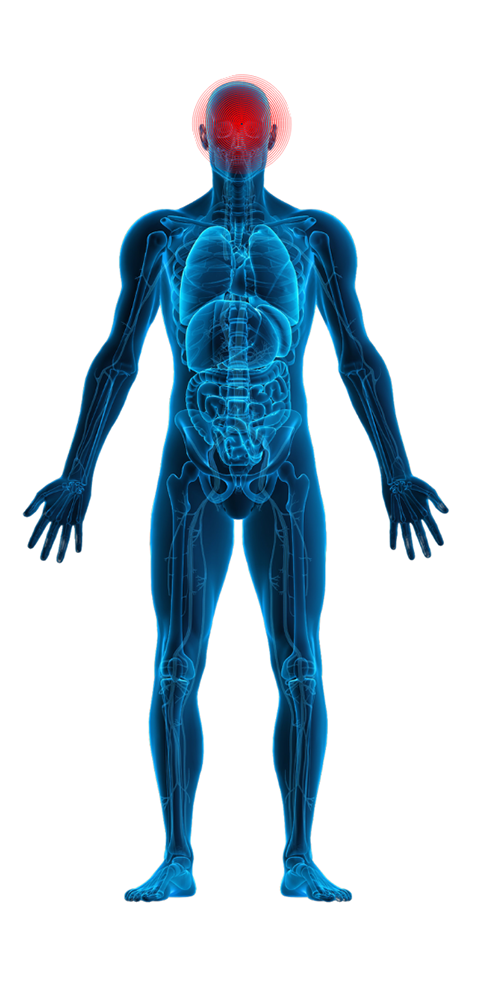Conditions:
Migraine
Migraine – Not Just Another Bad Headache
A migraine can be much more than just another headache. It can leave you in bed for days, not wanting to talk, text, socialize, or work. Nearly one person in every four U.S. households suffers from disturbing migraine symptoms. The condition is most prevalent in the ages of 18 to 44 and affects women more. If you are one of these, don’t let the dis-ease wear you down. Contact Renovaire Pain Care specialists and look at your options for pain-free living.

Is It Really A Migraine?
Not every headache is a migraine. There are many types of headaches, and most people don’t understand that. When you have a headache, you simply want to reach something for relief. But the catch is having frequent headaches that disturb your routine and can be highly distressing.
A migraine can be a sign of:
- An underlying health condition
- High stress levels
- Poor lifestyle habits
- Genetics
- Gender
Migraine, a type of headache with unique symptoms, calls for immediate medical attention. It is a neurological disorder that affects your nerves, spine, and brain, unlike tension headaches that affect both sides of the head without making you sick or sensitive to the triggers.
Migraine symptoms include:
- Pulsating or throbbing pain
- Neck stiffness
- Light or noise sensitivities
- Pain on either side of the head
- Nausea or vomiting
- Irritability
- Tiredness
- Difficulty speaking or concentrating
- Seeing flashing lights
- Disturbed visuals
- Temporary vision loss
- Tingling or numbing sensations
If you have been experiencing any of the listed symptoms or a new or unusual headache, get yourself checked. There can be several reasons behind a headache. But a qualified healthcare professional can determine whether you are going through a migraine or something else. A specialist might ask a series of questions or request a few tests to assess your case accurately.
Where Do Migraines Hurt?
Migraines usually start in the forehead, get onto the sides, and behind or around the eyes. A migraine can be on either side of the head, on top, at the back, temple area, neck, face, sinuses, or pain excruciatingly all around. The pain usually gets worse, and any activity or noise can hurt it more.
Different types of migraines may include:
- Migraine with or without aura
- Migraine without head pain (A.K.A., silent migraine)
- Migraine with temporary paralysis (hemiplegia)
- Ocular migraine (with partial or complete vision loss)
- Chronic migraine recurring every few days
Migraine Triggers
Migraine pain is a debilitating condition, one that is invisible to others but distressing for the sufferer. Common triggers include emotional stress, pregnancy, missing meals too often, food sensitivities, and too much caffeine, chocolate, or alcohol (red wine particularly). Others include daily migraine medications, irregular sleeping patterns, strong fragrances, hormonal changes, computer lights, sunlight, changing weather, overexertion, dehydration, etc.
Triggers can vary from person to person and can occur individually or in a combination. So, it helps if you remain proactive to see relief. Migraine triggers must be understood and avoided at all costs.
Living with a Migraine
Migraine symptoms put you in a position of physical as well as mental distress. Carrying out even routine activities doesn’t come easy since you do things with that pain in your head. The intensity of pain can be dull to mild and unbearable, and it drains your energy, leaving you flat for a couple of hours, even days. You feel your head is pounding nonstop, which can be crippling for most individuals, affecting their quality of life.
Migraines massively impact the sufferers’ personal, professional, and social life. People miss so many important days of their life. A dark room becomes a friend, things seem blurry, and getting help is the only way to get over it. There is no point in suffering; speaking to a specialist is the way to getting life back on track and easing the symptoms.
Seek Help Today
Migraines often decline with age or time, and you might see a noticeable change in your migraine symptoms in your 50s or 60s. However, living with migraines for that long can be life-altering.
Fortunately, at Renovaire Pain Care, we have integrative migraine treatments that help improve your condition without totally relying on risky migraine medications. We suggest that patients adjust their diet and lifestyle since migraine triggers can sometimes be inside rather than outside. You could be sensitive to specific food such as sulfates, nitrate preservatives, or those high in M.S.G. Stress and anxiety is another major factor causing migraine attacks.
Therefore, you must sleep well, eat healthily, consume more fluids, and never skip exercising. Take migraine medications under supervision, avoid triggers, and it will collectively help manage the symptoms.
Call Renovaire Pain Care physicians today at 281-768-4122 or write to us at info@RenovairePainCare.com to schedule a consultation.
